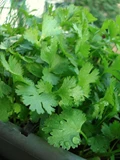
Coriander or Cilantro is an annual herb which is popularly known as dhania in Indian households. It is widely used for adding flavour and aroma to the food. All parts of the plant are edible, but majorly the fresh leaves and the dried seeds are used both as a herb and spice. It is widely cultivated for its culinary uses.
The plant produces a hollow stem 30 to 60 mm high with fragrant leaves. The flowers are small, pink or whitish in colour and a single globular fruit consist of 2 semiglobular fruits. Coriander is full of nutrition. It has high amount of Vitamin C, Vitamin K and protein as well as small levels of calcium, phosphorous, potassium, thiamin, niacin and carotene.
It is commonly believed growing coriander at home is a long and tiring process. It takes around three weeks for seeds to generate and leaves to sprout from them. But what if you could grow coriander within a week and that too without seeds? Mona Chopra from Ludhiana does this using a fresh bunch of coriander bought from the market. It's quite easy and simple.
Let's know how to make it.
For all this to work, make sure you use only fresh coriander. “The first and most important element to ensure success is the coriander bought from the market is fresh. Make sure the roots are tender and fresh,” said Mona.
“Often the roots have soil in them, and that could also indicate if the harvest is fresh,” Mona said. The expert suggests checking the roots by touching or slightly bending them to find roots are tender enough and not too dry. The next step is to cut the stem halfway. “The plant should get cut at least two to three inches above the roots or at the lower part of the shoots,” Mona said.
After the roots are separated, they can be directly put in water or in the soil depends on where you want to grow them. The coriander does not require a big pot or a thick layer of soil for its roots. A small 5-6 inches pot or a flatbed is an ideal place to grow the herbs,” Mona said.
The pot or flatbed prepared should have loose soil with organic manure or vermicompost. For this purpose, Mona said" Kitchen wet waste is the best to enrich the nutrition value of the soil. That’s what I do".
Keep the pot or flatbed in direct exposure to sunlight. In around four to five days, the fresh shoots or leaves will start growing. "The reason for leaves to grow faster is that rooting the plant directly in soil cuts down the germination and growing period of the plant from scratch.
The process is replanting the fully grown plant,” Mona said. Mona says that people on her Facebook page express doubts about the life of the plant or how many harvests could be achieved from a single plant.
“I have a mint plant grown similarly. I planted it last summer, and I am still sourcing fresh leaves for over a year now. If proper care gets taken, the plant continues to grow becoming an ever-ending source of coriander,” Mona said.
The home gardening expert says that a range of leafy vegetables like spinach, fenugreek, mint, and mustard can be grown through a similar process.
Also, read about the 4 best indoor plants for your home.











